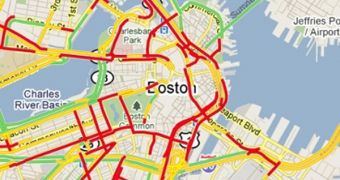A team of investigators at the MIT is proposing that cars be used as mobile, highly-efficient sensors for detecting traffic jams and other related issues that may delay traffic.
The team believes that all warning methods that now exist to tell drivers were circulation has stopped have drastic limitations, which cannot be easily compensated for.
For example, radio stations tend to deploy helicopters above main routes going in and out of a city, but that is very expensive, and pilots can only survey a limited number of roads at the same time.
Drivers can also follow indications provided by roadside sensors deployed by the US Department of Transportation, but these devices need time before they can detect a traffic jam.
A possible solution to all these issues could be the CarTel project, which is currently being developed by researchers at the Massachusetts Institute of Technology (MIT).
It was first presented on September 16, in front of experts participating at the sixth annual Workshop on Foundations of Mobile Computing, a meeting organized by the Association for Computing Machinery.
The very essence of CarTel is a computer algorithm, that enables the fast and reliable transmission of data throughout a network of wireless sensors installed in cars.
In other words, it allows cars to “speak” with each other, informing themselves as to where traffic jams occur. The MIT group is confident that this would make traffic considerably more fluid.
A considerable advantage that such a system would have over any other is that it could operate in rural areas as well, where cell phone towers and helicopter reports are scarce at best.
The proposal has already gained a lot of attention from automakers, and Ford has already began testing the algorithm. The company could include it in its next generations of the Sync in-car communications and entertainment system, which it develops with Microsoft.
The CarTel project is led by MIT computer science professor Hari Balakrishnan, who is working with associate professor Sam Madden. They have been in charge of developing the algorithm for four years.
The new algorithm was developed by postdoctoral student Calvin Newport and Alejandro Cornejo, who is a graduate student in Nancy Lynch’s Theory of Distributed Systems Group.
According to T.J. Giuli, the idea behind the algorithm could revolutionize traffic. The scientist is a technical expert on mobile computing at Ford Research and Advanced Engineering.
He is in charge of testing the algorithm in the field. Preliminary tests are looking promising, he says. One of the advantages that comes with wireless sensors is that bandwidth is no longer a problem.
“If more people are associated with the same cell base station, you kind of have to split the bandwidth among more and more people, so your effective bandwidth decreases,” Giuli explains.
But, by using sensors that connect vehicles wirelessly, “as the density of mobile-networking consumers increases, the bandwidth also increases,” he adds.

 14 DAY TRIAL //
14 DAY TRIAL //